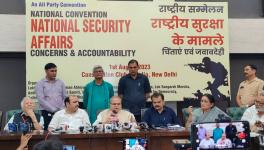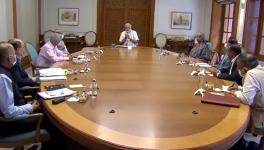Bye-Election Results Prove Gullibility is Very Short Term
Representational Image. File Image
Though attention remained focused on the Haryana and Maharashtra Assembly elections as votes were being counted on Thursday, the results for two Lok Sabha constituencies and 51 Assembly constituencies across the country were also being determined. In immediate terms, most of these were prestige fights since their outcomes would not change power equations. But they still offered a few lessons.
Bye-election results may sometimes be indicators of which way electoral fortunes are headed if they proximately precede a major election, but it is by no means certain they will, because the combined weight of imponderables can be crucial. Thus, in about a year leading to this year’s Lok Sabha elections, the ruling Bharatiya Janata Party (BJP) lost a string of bye-elections, including three in Uttar Pradesh, to candidates of a united Opposition.
When the elections actually rolled in, the BJP swept Uttar Pradesh, and Rajasthan and Madhya Pradesh where they had not only lost bye-elections but Assembly elections as well at the end of 2018. What had made this possible was an upsurge in Prime Minister Narendra Modi’s popularity fuelled by the cross-border airstrikes on Balakot in Pakistan, which made him look like the only man on the block who could be trusted to keep India safe from hostile neighbours and sponsored terrorists.
So, we must look at the results of these bye-elections with the question of their wider significance in mind. Of the two Lok Sabha bye-elections, one had been for Satara in Maharashtra and the other for Samastipur in Bihar. Ram Vilas Paswan’s Lok Janshakti Party retained Samastipur without too many alarms, but it was Satara that jolted the ruling party. The BJP had fielded a recent ‘defector’ from the Nationalist Congress Party (NCP), Udayanraje Bhonsle, a direct descendant of Chhatrapati Shivaji, who was supposed to win easily because of his lineage, power and influence. He had held the seat earlier as an NCP candidate. But Satara voters stood by the NCP and Bhonsle’s challenge failed.
The limited lesson from this NCP victory was that if a party worked hard enough, which Sharad Pawar’s outfit did, led by the septuagenarian’s indefatigable campaign, supposedly invincible opponents can be beaten.
The 51 Assembly bye-elections were spread over 17 states. In total, the BJP-led National Democratic Alliance (NDA) won 26 seats and the Congress 12. Of the 51 constituencies that had gone to the polls, nine were in the North-East. There was only one result of note as the BJP opened its account in Sikkim, winning two out of three seats. In Assam, the BJP won three out of four seats, while Badruddin Ajmal’s All India United Democratic Front won the fourth, wrested from the Congress.
The BJP retained two seats in Himachal Pradesh; the Congress one apiece in Chhattisgarh, Madhya Pradesh and Puducherry; the Biju Janata Dal retained a seat handsomely in Orissa; the AIADMK gave itself a booster shot winning two out of two in Tamil Nadu; and the Telangana Rashtra Samithi one in Telangana. These were all bread-and-butter results.
In Rajasthan, the Congress won one seat and the Rashtriya Loktantrik Party (RLP), an NDA constituent, one. The Congress wrested the seat from the BJP, while the RLP retained its seat. In Punjab, the Congress continued its dominance, winning three out of four seats, but the Shiromani Akali Dal pulled off a surprise, winning a seat vacated by Apna Dal.
In Kerala, the Left Democratic Front (LDF) picked up two out of five seats, while the United Democratic Front got the rest. But the most significant result there was LDF’s win from the Konni constituency, the ground zero of the Sabarimala agitation, beating the BJP, represented by K Surendran, the face of the Sabarimala agitation.
In Uttar Pradesh, where 11 bye-elections were held, the BJP retained eight seats, while the Samajwadi Party (SP) made gains, wresting a seat each from the BJP and the Bahujan Samaj Party, and retaining Rampur.
For the NDA, the most damaging results came in from Bihar and Gujarat. Bye-elections had been held in five constituencies in Bihar, all previously held by the Janata Dal-United (JD-U). It lost three of them, while ally BJP lost one. The JD-U scraped past in another. The BJP lost to a candidate from Asaduddin Owaisi’s All India Majlis-e-Ittehadul Muslimeen, while the JD-U lost two seats to the Rashtriya Janata Dal and one to an independent candidate who was a BJP rebel.
The BJP also suffered reverses in Gujarat, losing three seats out of six. Congress defector Alpesh Thakore was among the ruling party candidates defeated.
What seems to be indicated by these results is that all parties, more or less, managed to retain seats previously held, including the BJP and its allies. The only significant losses suffered were by NDA constituents: the BJP in Gujarat and JD-U in Bihar. Elsewhere, there were stray losses or gains—as with the SP in Uttar Pradesh and the Congress in Rajasthan.
What this in turn seems to indicate is that with national elections out of the way, people will not uncritically buy the national security rhetoric regularly peddled by the BJP. They want action on the things that affect their everyday life—essentially relating to economic performance. Unfortunately for the ruling party, it has over the past five years settled into a political mode in which the question of governance does not figure very prominently. It backs itself to get by on the basis of the Prime Minister’s charisma and popularity, continuous prevarication (including a pathological manipulation of official data) and a resort to gimmickry.
There can be no doubt that the BJP does both well. Its constant iteration of demonstrably false claims has often managed to convince a large segment of the electorate, while some of its gimmicks have succeeded spectacularly. But this round of elections seems to suggest that you can’t even keep fooling some of the people all of the time.
Suhit K Sen is an independent journalist and researcher in Kolkata. The views are personal.
Get the latest reports & analysis with people's perspective on Protests, movements & deep analytical videos, discussions of the current affairs in your Telegram app. Subscribe to NewsClick's Telegram channel & get Real-Time updates on stories, as they get published on our website.
























